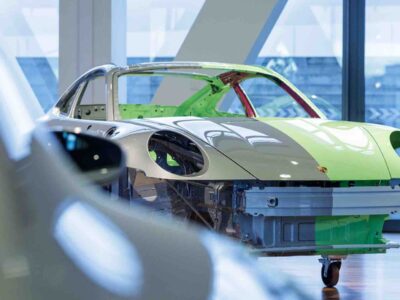Electric vehicle (EV) manufacturer Polestar is entering new waters, literally. In August, a multi-year deal was struck between Swedish Polestar and Candela Speed Boat to share and supply engine and charging equipment batteries. Candela plans to release a new line of electric boats for recreational use, along with mass transportation projects. Much like how EVs are rising in popularity, so are their electric water counterparts.
Candela’s vessels are unique because rather than sit directly on the water, they glide — in fact, almost fly — above the surface. Their innovative hydrofoils propel the boats above the surface line, allowing for a smoother ride with practically no wake produced from the motor seen with an internal-combustion engine. It’s also a much quieter ride.
The hydrofoils also use 25% less energy than typical powerboats since they don’t have to fight against the current as much as other vessels. The C-8 and P-8 models can reach speeds up to 30 knots, and when factoring in fossil fuel reduction, these speedboats use up to 80% less energy.
“Working together with Polestar, we’re able to bring the scale of production and world-class engineering from the automotive industry to the marine sector,” said Gustav Hesselskog, Candela CEO and founder. Projects like Candela’s are changing the marine transportation landscape.
The Polestar and Candela deal marks a new page in the track record of Scandinavian engineering. The two companies are working to overcome two major hurdles in electric boating: massive energy consumption and the high cost of marine batteries. The hydrofoils answered the energy consumption dilemma with an up to 80% energy reduction, rather than relying on the boat’s hull to cut through the water.
As for the second hurdle, Polestar’s battery technology allows for ramped-up production and greater range for the C-8 and P-8 models. Prior to this deal, Candela relied on smaller battery-tech firms, which were more costly and drove up the prices of the finished product. Polestar’s battery allows for a more cost-efficient and effective business strategy. The collaboration aims to get electric boats on a similar level of performance to internal combustion engines.
The joint venture comes during great publicity surrounding public transportation projects. A new C-8 model was launched in Venice, Italy, at the Salone di Nautico to test how an electric vessel would fare in the historic city’s canals.
Venice has dealt with boat wakes eroding building foundations for decades. The lack of wake from the hydrofoils has made the C-8 a very attractive option for water-based transportation. Plans for a Venetian electric water taxi are in the works, with the C-8 able to transport six people per ride in a timely manner.
Back in Sweden, Candela just completed a funding round for a $25.8 million 30-passenger ferry in Stockholm, set to be operational by 2023. The commercial-level boating projects could change water transportation as we know it.
Candela has also had success in private ownership sales. The company announced the C-8 model concept in the fall of 2021. By spring 2022, the firm had received more than 100 orders. The electric boat is gaining traction, even outselling some of the traditional rivals, and the Polestar deal will most likely help further the momentum. The question remains whether this growth will apply to more than leisure boating or small-scale public transportation.





